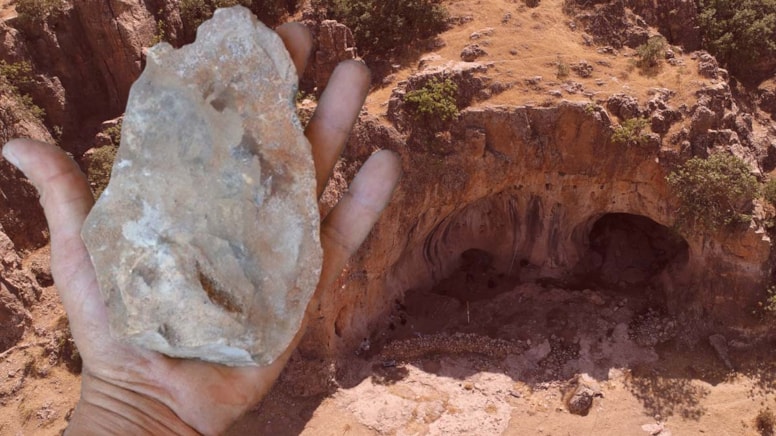
In a cave in southeastern Türkiye, traces of human life dating back 350,000 years have been discovered
In the Uluköy Cave located in the Gurs Valley of Mardin in southeastern Türkiye, traces of early human life believed to be 350,000 years old have been identified.
The rescue excavations at Uluköy Cave are being conducted under the leadership of Associate Professor Dr. Ergül Kodaş.
In the first season of the rescue excavations, findings dating back 200,000 years were reached. This year, in the cave, which is 23 meters long and 16 meters deep, teams that dug deeper obtained findings from the Paleolithic Age dating back 450,000 years.

Associate Professor Dr. Ergül Kodaş emphasized that they have gained significant information about the region’s culture and technology, dating from around 500,000 years ago to approximately 50,000 years ago.
Kodaş stated, “In the surface survey, we generally thought that the Paleolithic Age, which we refer to, dates back to before 20,000 years ago. However, through the excavations and the discovery of new layers, we realized that it actually goes back to around 450,000 to 500,000 years ago. In the first year of excavations, we estimated that the depth we reached dated back at least 250,000 to 200,000 years.

However, this year’s excavations allowed us to go deeper into these layers. The new findings from this area are also dated to the end of what we call the Acheulean culture (a culture standardized by the use of hand axes and cutting tools made from flakes by Homo sapiens and Homo erectus during the Paleolithic Age). This has led to the dating of the findings back to approximately 450,000 years.”
The excavation team generally encounters period-specific flint artifacts and numerous bone fragments during the excavations. These findings help understand the types of animal populations of the period and how humans fed themselves.

Kodaş noted, “In the flint artifacts, it was significant that we found more Yavridian flint tools, which are specific to the Levantine Syrian line and are older than 200,000 years. Additionally, there is a tradition that has been identified for the first time in Syria, which has also been detected in Anatolia at Uluköy Cave.”
“This is referred to as the ‘Hummal Industry’ tradition. These two findings are particularly important. The first is a flake, which is a flake on coarse Yavridian tools, where there are also Acheulean hand axes. With the Uluköy Cave excavations, this has been found for the first time in Anatolia.”

Right above this, there are materials from the Hummal Industry, which can be described as long-sized flakes where the technology of the “dilgi” (a type of flint or obsidian tool that is twice as long as it is wide) was used for the first time.

This is extremely valuable as it represents the first discovery of this in Anatolia at Uluköy. It indicates that at least during the Paleolithic Age, Southeastern Anatolia was an important point along the route leading to Africa, specifically along the Levantine Syrian line,” he stated.
Uluköy Cave is the first site in the Northern Mesopotamia region where cave excavations from the Paleolithic Age have been conducted.
You may also like
- A 1700-year-old statue of Pan unearthed during the excavations at Polyeuktos in İstanbul
- The granary was found in the ancient city of Sebaste, founded by the first Roman emperor Augustus
- Donalar Kale Kapı Rock Tomb or Donalar Rock Tomb
- Theater emerges as works continue in ancient city of Perinthos
- Urartian King Argishti’s bronze shield revealed the name of an unknown country
- The religious center of Lycia, the ancient city of Letoon
- Who were the Luwians?
- A new study brings a fresh perspective on the Anatolian origin of the Indo-European languages
- Perhaps the oldest thermal treatment center in the world, which has been in continuous use for 2000 years -Basilica Therma Roman Bath or King’s Daughter-
- The largest synagogue of the ancient world, located in the ancient city of Sardis, is being restored











Leave a Reply